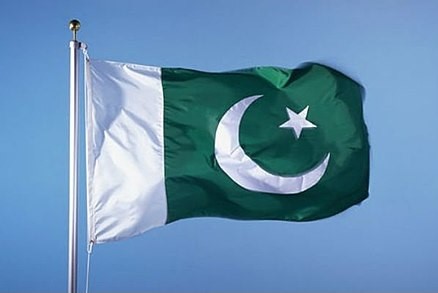Another bridge between India and Pakistan

![]() There is another spiritual bridge between people of India and Pakistan, and it deserves to be more widely known in India than it is. Thousands of Pakistanis assemble every Friday on their side of the border in the Ramgarh sector to pray at the shrine of Baba Ajit Singh Minhas who was killed about 100 years ago. It is located in Chamalial village, about 40 km from Jammu.
There is another spiritual bridge between people of India and Pakistan, and it deserves to be more widely known in India than it is. Thousands of Pakistanis assemble every Friday on their side of the border in the Ramgarh sector to pray at the shrine of Baba Ajit Singh Minhas who was killed about 100 years ago. It is located in Chamalial village, about 40 km from Jammu.
Pakistanis come up to the border escorted by the Sutlej Rangers, and pray at a distance from the shrine in the absence of any arrangements for them to cross into India for that purpose. Border Security Force personnel draw water (charanamrit) from a well in the compound of the shrine and give it to the Rangers who distribute it among Pakistanis. It is believed that the water cures skin diseases. According to legend, Ajit Singh, a Rajput, was murdered by his relatives over a land dispute at the place where the shrine is located.
The shrine is believed to have been constructed by a Muslim of Sialkot whose camel had been cured of skin disease after it had drunk water from a pond where Ajit Singh had fallen. The pond, however, does not exist today, but faith does. The present shrine was built by Border Security Force personnel after it had been destroyed during the 1971 war.
After Partition, descendants of Ajit Singh embraced Islam. Unable to come to India, they constructed a replica of the shrine on their side of the border in Saidanwala village where they pay homage to the memory of the Baba. The annual fair held in Chamalial village in June is a big draw. Pakistanis can come only up to the border, and Indians visit the shrine every year in their thousands.
While on the sanctity and traditional communal harmony of Jammu, it may be recalled that the town of Bhadarwah goes gay for two days every September when it celebrates the famous mela or Patt to commemorate return of King Nagpal from Delhi about four centuries ago. Though the dynasty of the Naga rulers ended in 1810 when the Raja of Chamba annexed Bhadarwah to his territory, people of this town still celebrate the fair which was inaugurated by that king. Tradition has it that Nagpal, who was a contemporary of Akbar, was summoned to Delhi by the Emperor. When he appeared before the Great Mogul, he did not bow his head. Asked to explain his conduct, Nagpal is believed to have said that he bowed his head only in front of his family deity, Vasuki Nag.
Enraged, the Emperor asked Nagpal to demonstrate the greatness of the deity. Thereupon, Nagpal prayed to Vasuki Nag, and there appeared from his turban a hooded cobra which began crawling towards the throne. The whole court was in a panic, and Akbar asked Nagpal to withdraw the cobra. Nagpal prayed and the cobra disappeared. The Emperor was so impressed with the spectacle as to present Nagpal with robes of honour (patt in Sanskrit).
-
Book Shelf
-
 Book Review
DESTINY OF A DYSFUNCTIONAL NUCLEAR STATE
Book Review
DESTINY OF A DYSFUNCTIONAL NUCLEAR STATE
- Book ReviewChina FO Presser Where is the fountainhead of jihad?
- Book ReviewNews Pak Syndrome bedevils Indo-Bangla ties
- Book Review Understanding Vedic Equality….: Book Review
- Book Review Buddhism Made Easy: Book Review
- Book ReviewNews Elegant Summary Of Krishnamurti’s teachings
- Book Review Review: Perspectives: The Timeless Way of Wisdom
- Book ReviewNews Rituals too a world of Rhythm
- Book Review Marx After Marxism
- Book Review John Updike’s Terrorist – a review
-
-
Recent Top Post
-
 News
Hong Kong Media: Safety Concerns Rise
News
Hong Kong Media: Safety Concerns Rise
-
 News
Alibaba’s Founder Returns to China
News
Alibaba’s Founder Returns to China
-
 News
Pak Urdu Media Digest – Mar 29, 2023
News
Pak Urdu Media Digest – Mar 29, 2023
-
 News
Congressional hearing examines Chinese repression in Tibet
News
Congressional hearing examines Chinese repression in Tibet
-
 News
China Accused of Meddling in Canada’s Elections
News
China Accused of Meddling in Canada’s Elections
-
 News
Exiled Leader Says Tibet Faces ‘Slow Death’ Under China
News
Exiled Leader Says Tibet Faces ‘Slow Death’ Under China
-
 News
Chinese coast guard ship chased out of Vietnam waters
News
Chinese coast guard ship chased out of Vietnam waters
-
 News
China Looks to Myanmar’s Rebel Armies to Shore Up Business, Border Goals
News
China Looks to Myanmar’s Rebel Armies to Shore Up Business, Border Goals
-
 News
China Tries to Block Prominent Uyghur Speaker at UNHRC
News
China Tries to Block Prominent Uyghur Speaker at UNHRC
-
 News
As Ramadan begins, China’s Muslims face fasting bans
News
As Ramadan begins, China’s Muslims face fasting bans
-
















